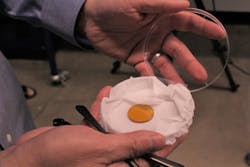New optical material for cheaper polymer IR lenses is found via computational chemistry
University of Arizona (Tucson, AZ) materials scientist Jeffrey Pyun and his colleagues are known for their creation of inexpensive polymer IR lenses using sulfur left over from refining fossil fuels. Now, with help from researchers at the University of Delaware (Newark, DE) and Seoul National University (Seoul, South Korea), the team has improved the material, devising new polymers that are stronger and more temperature-resistant than the first-generation sulfur plastic developed in 2014 that was transparent to mid-infrared wavelengths. The new high-refractive-index chalcogenide hybrid inorganic/organic polymers (CHIPs) lenses are transparent to a wider spectral window extending into the longwave-infrared (LWIR) region (7–14 μm) and are far less expensive than the current industry standard of lenses made of germanium, which is expensive, heavy, rare, and toxic.
Because of germanium’s many drawbacks, Tristan Kleine, one of the researchers, identified a sulfur-based plastic as an attractive alternative. But the components that give rise to useful optical properties, such as sulfur-sulfur bonds, also compromise the strength and temperature resistance of the material. Moreover, the inclusion of additional organic molecules to give the material strength resulted in reduced transparency since nearly all organic molecules absorb IR light, Kleine says. To overcome the challenge, the researchers used computational simulation to design organic molecules that are not IR-absorbing and predicted transparency of candidate materials. They then prepared CHIPs via inverse vulcanization of elemental sulfur with new organic co‐monomers. The new lens material could make IR cameras and sensor devices more accessible to consumers, says optical scientist Robert Norwood, a professor in the James C. Wyant College of Optical Sciences. Potential consumer applications include economical autonomous vehicles and in-home thermal imaging for security or fire protection. The team is partnering with Tech Launch Arizona to commercialize the technology. Reference: T. S. Kleine et al., Angew. Chem. (2019); https://doi.org/10.1002/ange.201910856.

John Wallace | Senior Technical Editor (1998-2022)
John Wallace was with Laser Focus World for nearly 25 years, retiring in late June 2022. He obtained a bachelor's degree in mechanical engineering and physics at Rutgers University and a master's in optical engineering at the University of Rochester. Before becoming an editor, John worked as an engineer at RCA, Exxon, Eastman Kodak, and GCA Corporation.
